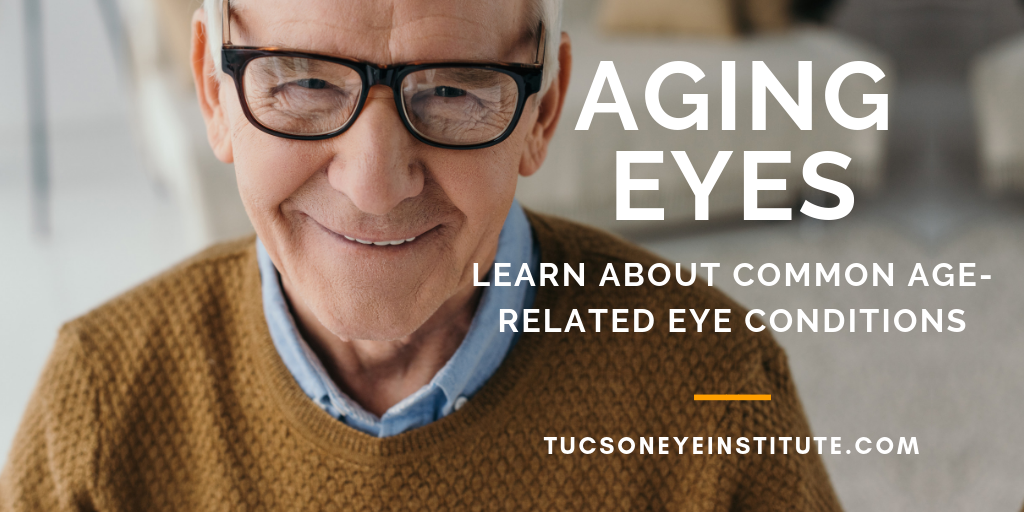Eyes and Aging
Sooner or later, aging begins to catch up with all of us.
Sure, you can (and should!) continue to take good care of yourself by eating right, getting lots of
You may even be able to reverse the flow of time—temporarily—by making big lifestyle changes to benefit your health.
But sooner or later, time catches up with all of us. Various biological systems don’t quite work as well as they used to. And for many people, the eyes are one of the most obvious examples of this.


Eye Conditions and Diseases Related to Aging
It might be easier to list out eye conditions that aren’t linked with aging! Still, here are some of the most significant age-related eye problems, diseases, and conditions:
Presbyopia
This is a fancy way of saying that you start losing the ability to focus on objects close to your eye.
Under normal circumstances, the lens of your eye flexes and bends as necessary so that incoming light can be focused properly on the retina. The closer the object you’re looking, the more the muscle controlling the lens must contract, and the more flexed the lens must be in order to see it clearly.
But as you get older, the lens gradually becomes harder and less flexible, meaning close objects become more difficult to see.
Fortunately, presbyopia can be counteracted successfully with corrective eyewear, which
Cataracts
Cataracts are very much a “not if, but when” condition. By age 80, more than half of Americans will have developed cataracts severe enough to impair their vision or warrant surgery.
As you get older, due to a lifetime of UV sun exposure and other factors, the delicate proteins that make up the lenses of your eyes begin to degrade and clump together. This changes the structure of the lens, making it thicker and cloudier in the areas where the proteins have degraded.
The result is
In the early stages, the day-to-day effects of cataracts can be lessened with conservative strategies. Past a certain point, though, surgery becomes the best option.
Dry Eyes
In order to keep them properly lubricated and protected, the whites of your eyes are covered with a mucous membrane called the conjunctiva. At the same time, your tear ducts produce basal tears which lubricate and nourish the eyes and keep them free of dust.
However, reduced tear production is a common effect of aging, and at the same
Dry eyes aren’t just irritating—in rare
Diabetic Retinopathy
Your risk of developing diabetes increases with age, and so too does your risk of diabetic complications—including diabetic retinopathy. That’s not only because older adults are more likely to have diabetes in the first place, but also because the longer you live with the disease, the greater the likelihood that elevated blood sugar levels over the years have caused substantial damage.
With diabetic retinopathy, sugar-related swelling and inflammation
In the most extreme cases,
Glaucoma
Glaucoma can refer to any of a number of related injuries and conditions in which the optic nerve becomes damaged. This creates patchy blind spots in your vision—peripheral, central, or both—and can eventually develop into tunnel vision (and then, finally, blindness in one or both eyes).
Usually, the underlying cause is a build-up of fluid pressure inside the eye, which presses on the nerve. Diabetic retinopathy is a common underlying cause, but certainly not the only one. It may simply be that the natural tissues and canals used to drain the eye become obstructed or plugged.
Age-Related Macular Degeneration
The keenest and most sensitive part of your retina is an oval-shaped area called the macula. It’s located in the center of the retina, and therefore responsible for providing your central vision.
As you age, the macula may begin to thin and break down. Your central vision slowly deteriorates, which can produce a range of symptoms—everything from funhouse-mirror style visual distortions to blurriness, poor nighttime vision, and even difficulty recognizing faces.
We don’t know why, exactly, macular degeneration forms, but we do know that it is increasingly likely to occur in people at least 50 years of age and older.


How to Protect Your Eyesight as You Age
Obviously, the proper treatment protocol for one condition (say, cataracts) is going to be very different from the proper treatment for a different condition, caused by different factors, affecting a different part of the eye (for example, glaucoma).
However, one thing that virtually all these conditions have in common? The earlier you discover the problem and seek to treat it, the better off you’ll be in the long run.
And that means you need a comprehensive eye exam every year—even if you don’t currently wear glasses or contacts.
See, another thing a lot of these conditions have in common is that they develop slowly. Your vision may have deteriorated quite a bit from your younger days, but since it worsens little by little, you might not have even really noticed how bad it’s gotten.
But a comprehensive eye exam from Dr. Zie can detect the early signs of cataracts, macular degeneration, glaucoma, and other conditions—which could cause blindness if not treated in time—long before you can on your own.
In those months between your eye exams, remember that living a healthy lifestyle and protecting your eyes can help slow the aging process and keep your vision sharper for longer.
Eating right, getting lots of
If it’s been too long since you stopped by for a comprehensive eye exam, we encourage you to give the team at Tucson Eye Institute a call today! We want to help you keep your eyes healthy and your vision strong. To schedule, call us at (520) 585-5717 today.
Contact Us
Office Hours:
Monday - Friday
8:00AM - 5:00PM
By Appointment Only:
First Saturday of the month from 8:00AM - 2:00PM
© Tucson Eye Institute. All Rights Reserved.
Web Design by CP Solutions. Marketed by VMD Services. Privacy Policy
